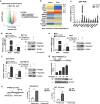Enhanced PAPSS2/VCAN sulfation axis is essential for Snail-mediated breast cancer cell migration and metastasis
- PMID: 29955124
- PMCID: PMC6370781
- DOI: 10.1038/s41418-018-0147-y
Enhanced PAPSS2/VCAN sulfation axis is essential for Snail-mediated breast cancer cell migration and metastasis
Abstract
The zinc finger protein Snail is a master regulator of epithelial-mesenchymal transition (EMT) and a strong inducer of tumor metastasis, yet the signal cascades triggered by Snail have not been completely revealed. Here, we report the discovery of the sulfation program that can be induced by Snail in breast cancer cells, and which plays an essential role in cell migration and metastasis. Specifically, Snail induces the expression of PAPSS2, a gene that encodes a rate-limiting enzyme in sulfation pathway, and VCAN, a gene that encodes the chondroitin sulfate proteoglycan Versican in multiple breast cancer cells. Depletion of PAPSS2 in MCF7 and MDA-MB-231 cells results in reduced cell migration, while overexpression of PAPSS2 promotes cell migration. Moreover, MDA-MB-231-shPAPSS2 cells display a significantly lower rate of lung metastasis and lower number of micrometastatic nodules in nude mice, and conversely, MDA-MB-231-PAPSS2 cells increase lung metastasis. Similarly, depletion of VCAN dampens the cell migration activity induced by Snail or PAPSS2 in MCF 10A cells. Moreover, PAPSS inhibitor sodium chlorate effectively decreases cell migration induced by Snail and PAPSS2. More importantly, the expression of Snail, PAPSS2, and VCAN is positively correlated in breast cancer tissues. Together, these findings are important for understanding the genetic programs that control tumor metastasis and may identify previously undetected therapeutic targets to treat metastatic disease.
Conflict of interest statement
The authors declare that they have no conflict of interest.
Figures







Similar articles
-
Effect of estrogen sulfation by SULT1E1 and PAPSS on the development of estrogen-dependent cancers.Cancer Sci. 2012 Jun;103(6):1000-9. doi: 10.1111/j.1349-7006.2012.02258.x. Epub 2012 Apr 11. Cancer Sci. 2012. PMID: 22380844 Free PMC article.
-
miR-181b-3p promotes epithelial-mesenchymal transition in breast cancer cells through Snail stabilization by directly targeting YWHAG.Biochim Biophys Acta. 2016 Jul;1863(7 Pt A):1601-11. doi: 10.1016/j.bbamcr.2016.04.016. Epub 2016 Apr 18. Biochim Biophys Acta. 2016. PMID: 27102539
-
CHST2-mediated sulfation of MECA79 antigens is critical for breast cancer cell migration and metastasis.Cell Death Dis. 2023 Apr 24;14(4):288. doi: 10.1038/s41419-023-05797-x. Cell Death Dis. 2023. PMID: 37095090 Free PMC article.
-
Human 3'-phosphoadenosine 5'-phosphosulfate (PAPS) synthase: biochemistry, molecular biology and genetic deficiency.IUBMB Life. 2003 Jan;55(1):1-11. doi: 10.1080/1521654031000072148. IUBMB Life. 2003. PMID: 12716056 Review.
-
Bone Phenotype is Always Present But Androgen Excess is Less Frequently Seen in PAPSS2 Deficiency.J Clin Res Pediatr Endocrinol. 2024 Mar 11;16(1):4-10. doi: 10.4274/jcrpe.galenos.2023.2023-12-10. Epub 2023 Dec 12. J Clin Res Pediatr Endocrinol. 2024. PMID: 38084048 Free PMC article. Review.
Cited by
-
The YAP/SERCA2a signaling pathway protects cardiomyocytes against reperfusion-induced apoptosis.Aging (Albany NY). 2020 Jul 9;12(13):13618-13632. doi: 10.18632/aging.103481. Epub 2020 Jul 9. Aging (Albany NY). 2020. PMID: 32645692 Free PMC article.
-
Human Mesenchymal Stem Cells Derived from the Placenta and Chorion Suppress the Proliferation while Enhancing the Migration of Human Breast Cancer Cells.Stem Cells Int. 2022 Nov 11;2022:4020845. doi: 10.1155/2022/4020845. eCollection 2022. Stem Cells Int. 2022. PMID: 36406002 Free PMC article.
-
Up-regulation of EMT-related gene VCAN by NPM1 mutant-driven TGF-β/cPML signalling promotes leukemia cell invasion.J Cancer. 2019 Oct 21;10(26):6570-6583. doi: 10.7150/jca.30223. eCollection 2019. J Cancer. 2019. PMID: 31777586 Free PMC article.
-
TGF-β1 dominates stromal fibroblast-mediated EMT via the FAP/VCAN axis in bladder cancer cells.J Transl Med. 2023 Jul 17;21(1):475. doi: 10.1186/s12967-023-04303-3. J Transl Med. 2023. PMID: 37461061 Free PMC article.
-
GATA zinc finger protein p66β promotes breast cancer cell migration by acting as a co-activator of Snail.Cell Death Dis. 2023 Jun 28;14(6):382. doi: 10.1038/s41419-023-05887-w. Cell Death Dis. 2023. PMID: 37380643 Free PMC article.
References
-
- Alberga A, Boulay JL, Kempe E, Dennefeld C, Haenlin M. The snail gene required for mesoderm formation in Drosophila is expressed dynamically in derivatives of all three germ layers. Development. 1991;111:983–92. - PubMed
Publication types
MeSH terms
Substances
LinkOut - more resources
Full Text Sources
Other Literature Sources
Medical
Research Materials
Miscellaneous

